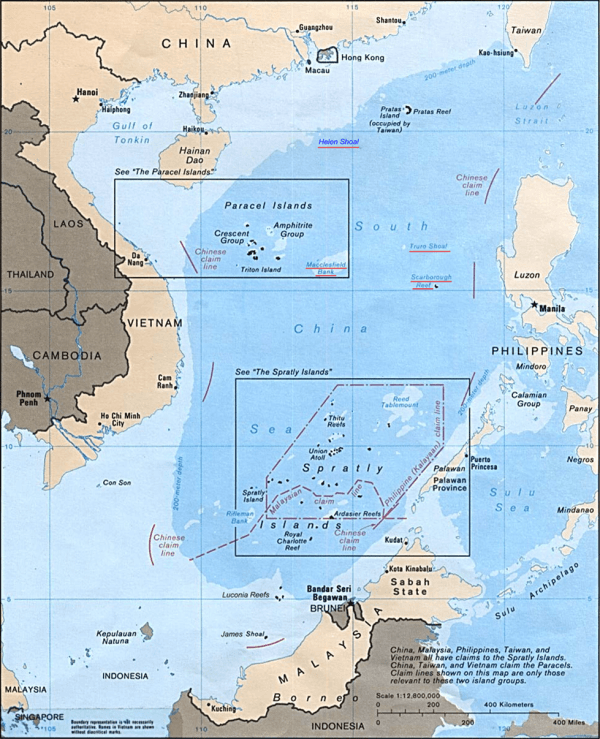China continues to build advanced radar bases, major runways and landing strips, hardened storage depots, and forward positioning facilities in the South China Sea. With U.S. attention focused on a bellicose North Korea, and a compliant President Duterte in the Philippines, China is quietly hardening its presence on the disputed islands. A recent report from the Asia Maritime Transparency Initiative includes satellite imagery showing the new Chinese construction.
The Asia Maritime Transparency Initiative
The Asia Maritime Transparency Initiative (AMTI) is a project sponsored by the Center for Strategic and International Studies (CSIS) in Washington, DC. AMTI strives to be a neutral party, restricting itself to merely observing and reporting events in the Pacific region. The AMTI website makes its position quite clear.
“AMTI was conceived of and designed by CSIS. It is an interactive, regularly-updated source for information, analysis, and policy exchange on maritime security issues in Asia. AMTI aims to promote transparency in the Indo-Pacific to dissuade assertive behavior and conflict and generate opportunities for cooperation and confidence building. Because AMTI aims to provide an objective platform for exchange, AMTI and CSIS take no position on territorial or maritime claims…. AMTI aggregates information from news sources, as well as specially designated research and nonprofit organizations, public sector institutions in Asia, and individuals.”
South China Sea “Code of Conduct”
This construction took place while China has engaged its Pacific counterparts in ongoing and drawn out discussions about process. The Chinese have signaled a willingness to engage in negotiations over a “code of conduct” regarding the disputed islands. It will be difficult to agree to a code, given the wide gulf in expectations currently evinced by the parties.
The Chinese consider it acceptable for them to build military installations on disputed islands, but consider it a violation if the Australians watch them do it.
For example, the Chinese consider it acceptable for them to build military installations on disputed islands, but consider it a violation if the Australians watch them do it. The Brisbane Times reported, “China’s naval chief Shen Jinlong told his Australian counterpart, Vice Admiral Tim Barrett that Canberra’s actions in the South China Sea run counter to the general trend of peace and stability in one of the world’s most important shipping lanes.”
“This does not accord with the consensus reached by the leaders of the two countries nor the atmosphere of the forward steps in cooperation in all areas between the two countries,” Jinlong said. The actions that China thinks run ‘counter to the general trend of peace and stability’ may be surprising. Australia has made surveillance flights over the islands, to see what China is doing, and it provides support to U.S. patrols in the region.
The (South China Sea) Shell Game
Meanwhile, China’s client state, North Korea, continues testing sophisticated missiles with the capacity to reach the American mainland. President Trump has told China repeatedly that it must rein in its dependent to the east, but Chinese leaders continue to claim inability to control Pyongyang. The new satellite photos from AMTI may offer a clue to why the North Korean crisis is still unresolved. It is in China’s interest to keep the U.S. off balance and distracted while China enforces its will in the Spratlys, the Paracels, and the other islands in the area.

In the case of the islands, the “code of conduct” is still only theoretical, but China still is speaking as if the U.S. and its allies are violating it.
This is in keeping with longstanding practice in Chinese negotiating behavior. Ambassador Richard Solomon wrote a monograph about Chinese political negotiating behavior in 1995 for RAND. In it, he listed dozens of common bargaining practices, one of which was titled, descriptively, “You’re Violating the Principles of the Relationship!”
Solomon writes, “Having worked assiduously in the early phase of a negotiation to gain a counterpart government’s commitment to certain general principles, the PRC negotiator will sue that commitment to constrain his interlocutor’s action as the relationship evolves.” Solomon’s experience dealt with U.S. arms sales to Taiwan. At least in that case, there actually was an existing agreement of principles to argue about. In the case of the islands, the “code of conduct” is still only theoretical, but China still is speaking as if the U.S. and its allies are violating it.
It is possible that the world’s search for a solution to North Korean aggression does not lie in either Pyongyang or in Beijing. Perhaps we should be looking much farther south, to the Spratly and Paracel Islands. That may be the game China has been playing all along.
















